This recipe for baked salmon is a great option for anyone looking to prepare a healthy and flavorful meal in less than 20 minutes! The simple ingredients and easy cooking method make this recipe a go-to for busy weeknights and the salmon comes out perfectly moist and delicious every time.
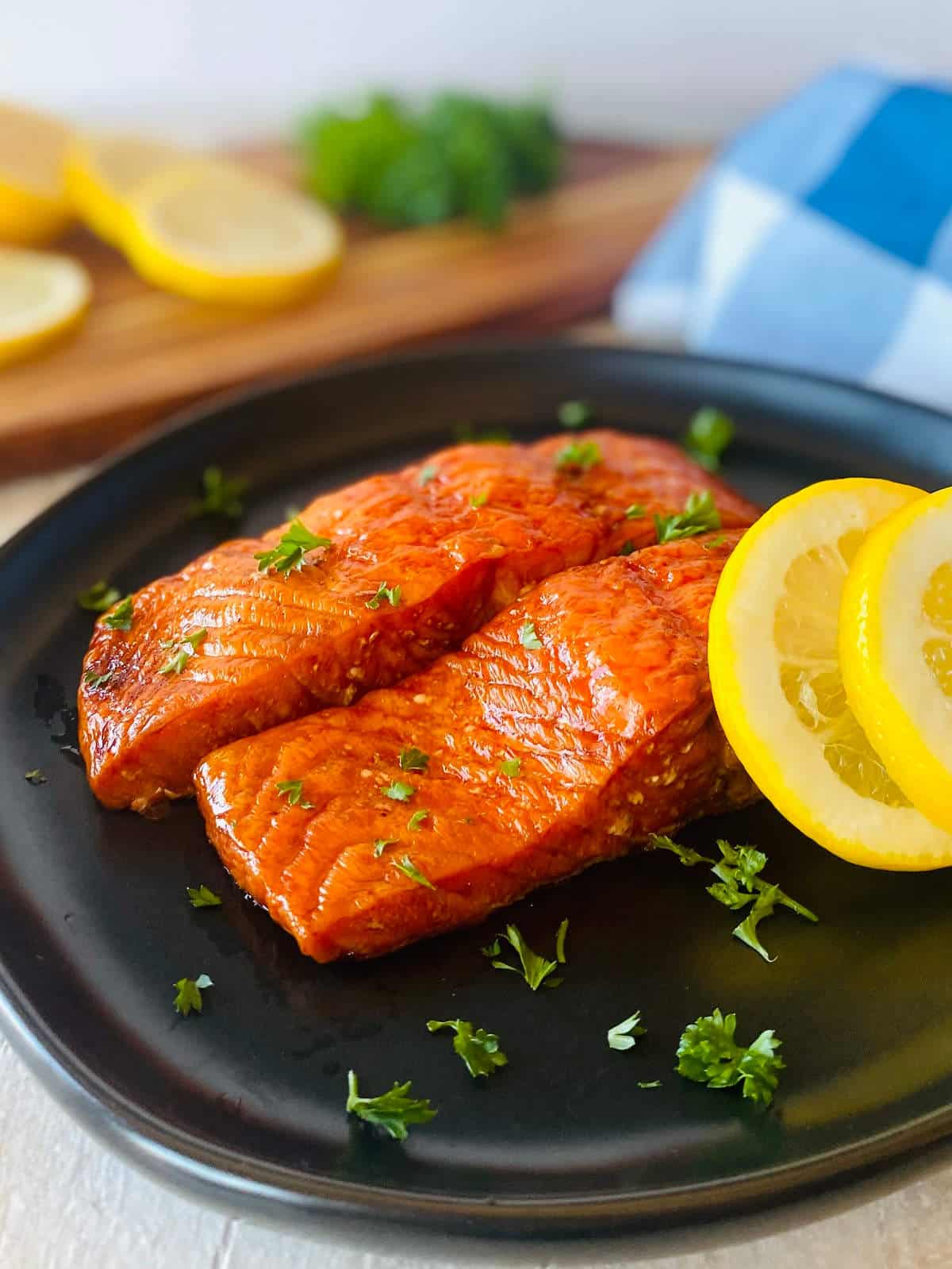
This post may contain affiliate links which means I may receive commissions if you choose to purchase through this link (at no extra cost to you).
Salmon is a popular choice for a healthy and flavorful meal, and baking it is a quick and easy cooking method.
From easy family meal (Baked Salmon with Lemon) to romantic date night Pistachio Crusted Salmon) or Wagyu Steak, we have got you covered!
Looking to get adventurous, check out this Smoked Whole Chicken. Feeling like some hearty soup? This Shrimp and Corn Bisque will satisfy those seafood cravings.
Salmon is a rich source of protein, omega-3 fatty acids, and various vitamins and minerals, making it a nutritious choice for people of all ages.
Baked salmon can be served as a main dish or used in a variety of dishes, such as salads, sandwiches, or pasta.
It can also be a full meal using a sheet pan! Check out this Sheet Pan Salmon and Veggies for an easy weeknight meal! Looking to get a little fancy, you will love this Smoked Pork Loin!
There are many different ways to bake salmon (like this amazing smoked salmon recipe!), and the cooking time and temperature will depend on the thickness and size of the fillets.
My favorite way to bake salmon is at 425°F (220°C): for approximately 15 minutes, or until it is cooked to your desired level of doneness.
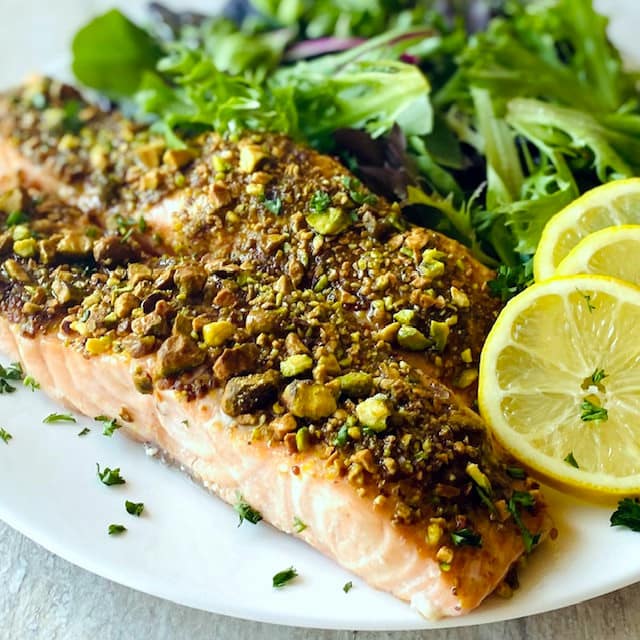
It is important to remember that the time and temperature of your salmon will depend on the type of salmon you are cooking, the oven, the elevation and the cookware which can cause variations.
If you aren’t sure, it is always a great idea to check the internal temperature of your fish.
One of the great things about baked salmon is that it is very versatile and can be flavored in many different ways. In addition to using herbs and spices, you can also top the salmon with a variety of sauces or marinades or try this Furikake salmon!
Lemon juice, soy sauce, honey, and teriyaki sauce are all popular options. A few of my favorites include Chimichurri, Mango Salsa, a dollop of spicy Chili Crisp or this amazing Asian inspired Salmon Marinade.
You can also mix and match ingredients to create your own unique flavors, such as a delicious lemon garlic butter sauce. If you want to bake the salmon in the oven, you can use a rimmed baking sheet lined with foil or parchment paper. This will make it easier to clean up and prevent the salmon from sticking.
Brush the salmon with olive oil to help it cook evenly and add flavor. If you don’t want to use the oven, there are other options for cooking salmon as well. You can cook salmon in an air fryer (we love these Air Fryer Salmon Bites) or in an Instant Pot.
Both of these methods are faster and use less oil than traditional baking, so they can be a good option if you are looking for a healthy salmon recipe.
If you decide to bake the salmon in the oven, you can either leave the skin on or remove it. If you leave the skin on, it will help to keep the salmon moist and flavorful, but it may be more difficult to remove after cooking.
If you prefer to remove the skin, you can use a sharp knife to carefully slide it off the fillet. Ultimately, crispy baked salmon is the goal.
Baking salmon is a simple and straightforward process, and it is a great option for busy weeknights or when you want to prepare a healthy meal without spending a lot of time in the kitchen.
Whether you are an experienced cook or just starting out, this is a recipe that is sure to become a staple in your meal rotation.
Why this recipe works
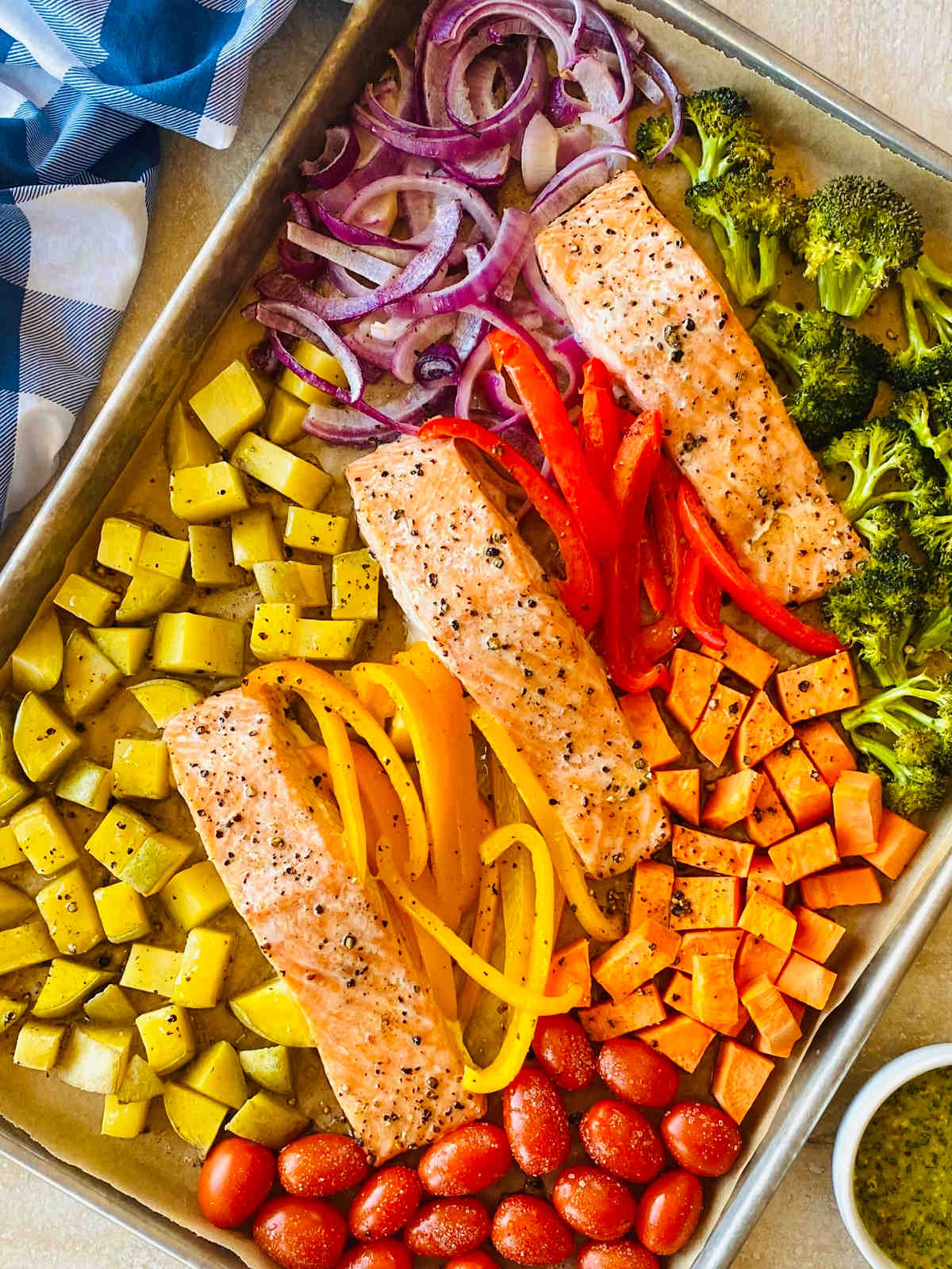
- The salmon is baked in the oven, which is a quick and easy cooking method.
- The lemon juice and herbs add flavor to the salmon without overpowering it. Salmon is a very sturdy fish and works well with many different cooking preparations.
- The salmon comes out moist and tender every time, thanks to the olive oil coating.
Ingredients
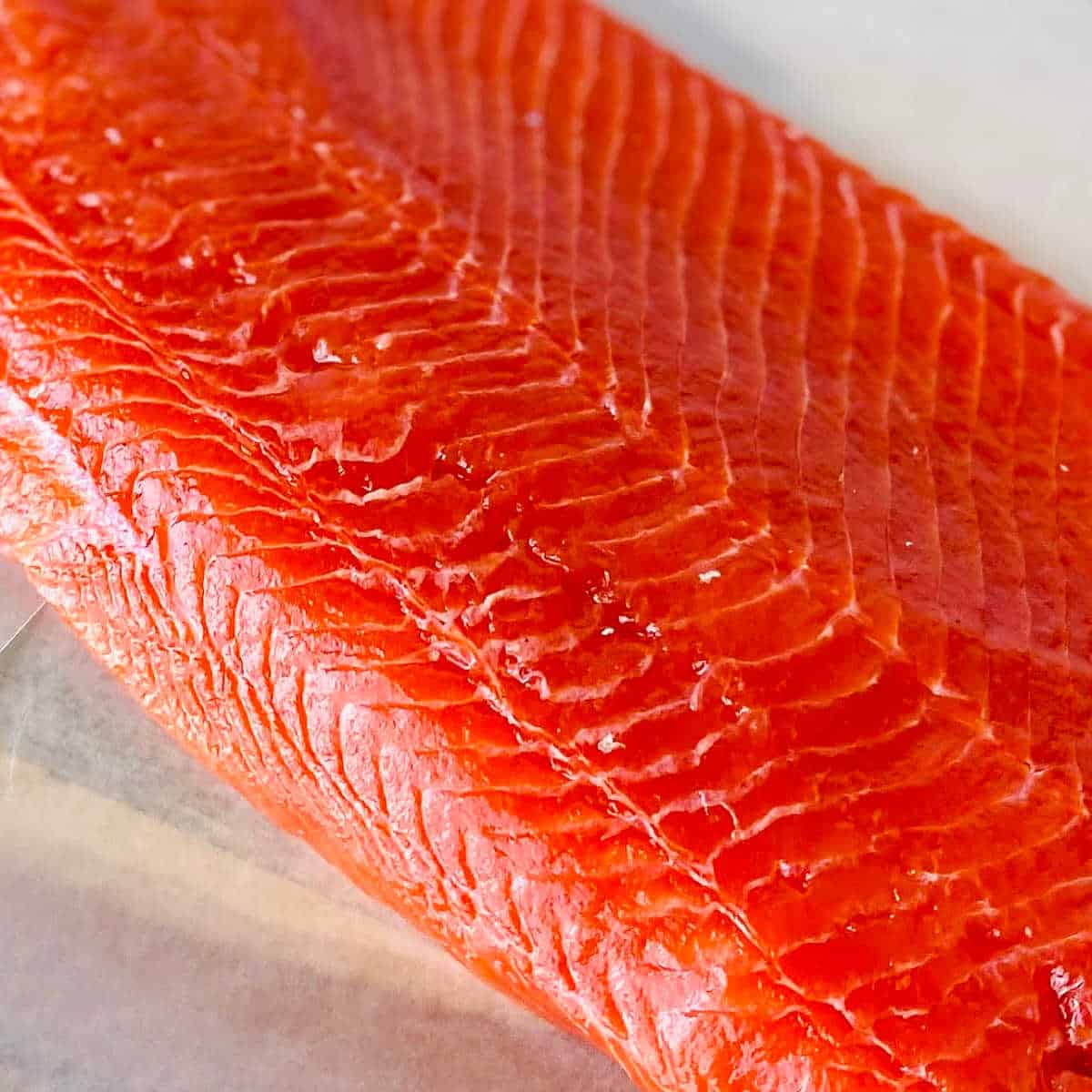
- Salmon: When buying salmon, look for fillets that are firm to the touch and have a shiny, moist appearance. Avoid fillets that are dry or have a strong fishy smell. It is also important to consider where your salmon is coming from. Wild-caught salmon may be more expensive, but it is generally considered to be of higher quality and more sustainable than farmed salmon.
- Olive Oil: In addition to olive oil, you can use canola oil, vegetable oil, avocado oil, peanut oil or grapeseed oil.
- Seasonings: Any seasonings you enjoy. Some favorites are lemon zest, dried basil, dried oregano, garlic powder, onion powder, paprika, dill, parsley, cumin, chili powder, cayenne pepper, Old Bay seasoning, fennel seeds, coriander, mustard seeds, celery seeds, black pepper, white pepper, anise seeds, and turmeric.
- Salt: I recommend kosher salt.
- Pepper: Fresh ground black pepper.
- Lemon Juice: Fresh lemon juice.
How to bake salmon

- Preheat your oven to 425°F (220°C).
- Pat salmon fillets dry with a paper towel. Place the fillets in a baking dish.
- Brush the salmon fillets with olive oil, using a brush to evenly coat the fish. Sprinkle with seasonings, salt, pepper and/or fresh herbs of choice over the top of the salmon.
- Bake the salmon in the preheated oven for 13-16 minutes, or until it is cooked to your desired level of doneness.
- To test for doneness, insert a food thermometer into the thickest part of the salmon. The internal temperature of the salmon should be at least 145°F (63°C), according to the U.S. Food and Drug Administration (FDA). Continue baking it in 3-minute increments until it reaches the proper temperature.
- Once the salmon is cooked, remove it from the oven and let it sit for a few minutes before serving. This will allow the juices to redistribute and make the salmon even more flavorful and tender.
- Squeeze the juice of fresh lemon on top if desired.
Health benefits of salmon
Salmon is a nutritious and delicious type of fish that offers a wide range of health benefits. Here are five reasons why salmon is good for your health (I recommend sustainably sourced salmon!):
- High in protein: Salmon is a good source of protein, which is essential for building and repairing tissues in the body. Protein is also important for maintaining muscle mass and supporting a healthy metabolism.
- Rich in omega-3 fatty acids: Salmon is one of the best sources of omega-3 fatty acids, which are a type of polyunsaturated fat that is important for heart health. Omega-3s can help to lower blood pressure, reduce the risk of heart disease, and reduce inflammation in the body.
- Good for brain health: Omega-3s have also been shown to support brain health, and some research suggests that they may help to reduce the risk of cognitive decline and dementia.
- High in vitamins and minerals: Salmon is a good source of several vitamins and minerals, including vitamin B12, vitamin D, and selenium. These nutrients are important for maintaining good overall health and well-being.
- May help with weight loss: Some research suggests that salmon may be helpful for weight loss, as it is low in calories and high in protein. This can help to keep you feeling full and satisfied, which may help to prevent overeating.
How long to bake salmon at each oven temperature
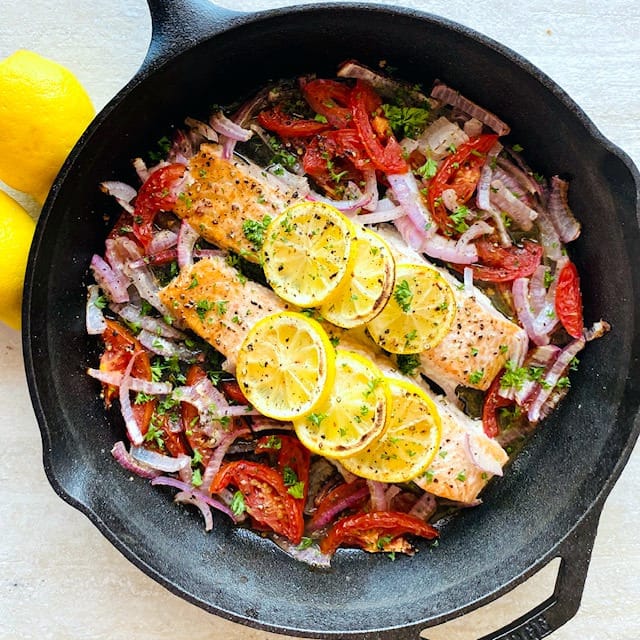
The cooking time for baked salmon will depend on the thickness and size of the fillets, type of salmon, elevation, type of oven and your desired level of doneness.
Keep in mind that these cooking times are estimates, and the actual time may vary depending on the specific characteristics of your salmon. To test for doneness, insert a fork into the thickest part of the fish and twist gently. If the fish flakes easily, it is ready. If it is still quite firm, it may need a few more minutes of cooking.
I generally recommend a thermometer to test for doneness, as the actual cooking time may vary. Insert a food thermometer into the thickest part of the salmon. The internal temperature of the salmon should be 145°F (63°C). If the salmon is not quite done, you can continue baking it in 3-minute increments until it reaches the proper temperature.
How long to bake salmon at 350°F
Bake salmon in oven at 350°F (180°C) for 15-20 minutes.
How long to bake salmon at 375°F
Bake salmon in oven at 375°F (190°C) for 14-19 minutes.
How long to bake salmon at 400°F
Bake salmon in oven at 400°F (200°C) for 13-16 minutes.
How long to bake salmon at 425°F
Bake salmon in oven at 425°F (220°C) for 13-15 minutes.
How long to bake salmon at 450°F
Bake salmon in oven at 450°F (230°C) for 12-15 minutes.
How long can cooked salmon stay in the fridge?
Cooked salmon can be stored in the refrigerator for up to 3 days. To store cooked salmon, place it in an airtight container or wrap it tightly in aluminum foil or plastic wrap. If you are storing the salmon in a container, be sure to remove any excess air to help prevent spoilage.
It is important to keep cooked salmon refrigerated to prevent the growth of harmful bacteria. If the salmon has been left out at room temperature for more than 2 hours, it should be discarded to prevent the risk of food poisoning.
If you are not planning to eat the cooked salmon within 3 days, it can be frozen for longer storage. To freeze cooked salmon, place it in an airtight container or wrap it tightly in aluminum foil or plastic wrap. When you are ready to eat the salmon, thaw it in the refrigerator and reheat it to an internal temperature of 145°F (63°C).
Best types of salmon to bake
The best type of salmon for baking will depend on your personal preferences and the recipe you are using. In general, salmon with a higher fat content, such as Chinook or sockeye, will be more flavorful and moist when baked. However, these types of salmon may also be more expensive.
Coho and pink salmon are leaner options that may be more budget-friendly, but they may be less moist when baked. Atlantic salmon is also a common choice for baking, as it is widely available and has a mild, slightly sweet flavor.
Ultimately, the best type of salmon for baking will depend on your taste preferences and budget. You may want to try experimenting with different types of salmon to find the one that you like the best.
Should I bake salmon skin-on or skin-off?
There are a few things to consider when deciding whether to bake salmon with the skin on or off:
- Moisture: Baking salmon with the skin on can help to keep the flesh moist and prevent it from drying out. However, if you prefer a crispier texture, you may want to remove the skin before baking.
- Flavor: The skin of salmon can add a rich, savory flavor to the flesh when it is baked. However, if you do not like the taste of salmon skin, you may prefer to remove it before baking.
- Presentation: Some people prefer to remove the skin before baking because it can be difficult to serve and eat. Others may enjoy the presentation of a baked salmon fillet with the skin still attached.
Ultimately, whether you bake salmon with the skin on or off will depend on your personal preferences and the recipe you are using. You may want to try both methods to see which you prefer.
Best salmon to buy
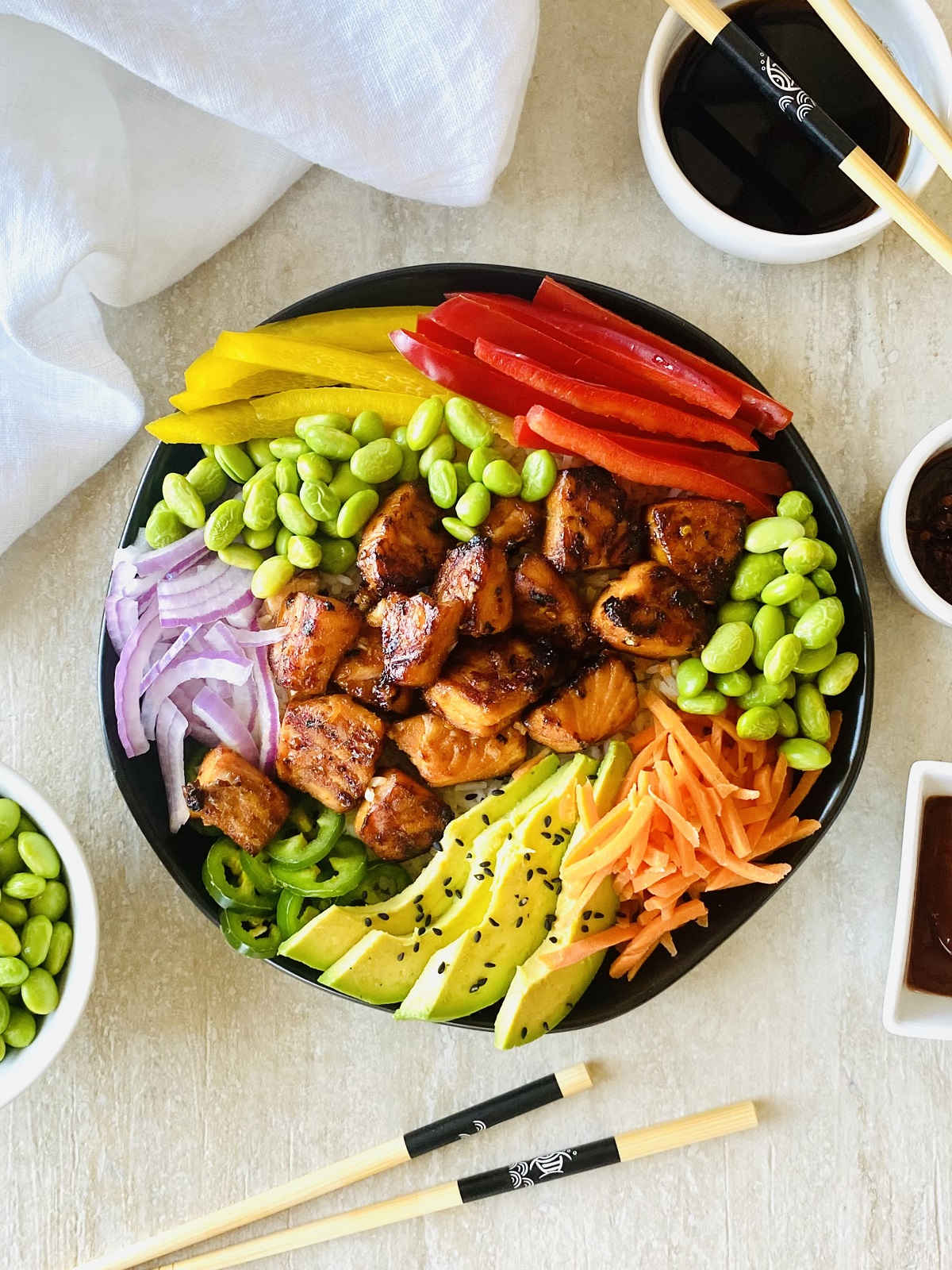
If you want to order the best sustainable salmon from my favorite seafood company, you can click on any of my links in this post to receive $15 off your first order at Wild Alaskan Seafood Company!
I am envious of those who live close to the sea and can obtain sustainable, responsibly sourced fresh seafood and wild caught salmon. For me, trying to find good seafood and salmon at local grocery stores in Arizona can be challenging to say the least and you need the best for oven baked salmon (roasted salmon).
Learning how to bake the best salmon requires the best ingredients so hopefully this helps!
Side dishes for salmon
When choosing side dishes to serve with salmon, it is important to consider the flavor and texture of the fish. Salmon has a rich, slightly fatty flavor, so it pairs well with side dishes that are light and refreshing, or that have bold and complementary flavors.
It is also a good idea to choose side dishes that can be prepared in a similar amount of time as the salmon, so that everything is ready to serve at the same time.
With that in mind, here are some ideas for side dishes to serve with salmon:
- Roasted vegetables: Roasted vegetables such as roasted asparagus, broccoli, bell peppers, and Brussels sprouts are a healthy and flavorful side dish for salmon.
- Salad: A simple green salad, roasted beet salad or a more elaborate grain or bean-based salad makes a great side for salmon.
- Grains: Quinoa, instant pot rice, farro, and other grains are a versatile side dish that can be flavored in many different ways.
- Potatoes: Roasted, mashed, or boiled potatoes are a classic side dish for salmon. Diced potatoes in air fryer are a quick and easy option.
- Pasta: A simple pasta dish such as spaghetti with marinara sauce or lobster ravioli sauce can be a delicious accompaniment to salmon.
- Beans: Green beans, chickpeas, and other beans can be served as a side dish for salmon.
- Slaw or Salsa: A refreshing slaw or salsa recipe made with cabbage, carrots, and other vegetables is a great side for salmon.
- Bread: A slice of bread or air fryer garlic bread can be served alongside salmon to soak up any sauces or juices.
How to bake salmon in foil
Baking salmon in foil is a quick and easy way to prepare a delicious and healthy meal. The foil helps to seal in moisture and prevent the fish from drying out, resulting in tender and flavorful salmon every time. Here’s how to oven bake salmon in foil:
- Preheat your oven to 400°F (200°C).
- Rinse the salmon fillets under cold water and pat them dry with a paper towel.
- Cut a piece of foil that is large enough to wrap around the salmon fillets. Place the fillets in the center of the foil, and season them with salt and pepper on both sides.
- In a small bowl, mix together a few tablespoons of olive oil, the juice of half a lemon, and any herbs or spices you prefer. Pour the mixture over the salmon fillets, using a brush to evenly coat the fish.
- Fold the foil over the salmon fillets to create a packet, being sure to seal the edges tightly to prevent any leakage.
- Place the foil packet on a baking sheet and bake the salmon in the preheated oven for 12-15 minutes, or until it is cooked to your desired level of doneness.
- Once the salmon is cooked, remove it from the oven and let it sit for a few minutes before serving. This will allow the juices to redistribute and make the salmon even more flavorful and tender.
- Serve the salmon hot, with the remaining lemon juice mixture spooned over the top. Enjoy!
You can customize this recipe to suit your own taste preferences by using different herbs and spices, or by trying different types of oil or marinades. Baking salmon in foil is a versatile and convenient way to prepare a healthy and flavorful meal in a short amount of time.
How do you cook cedar plank salmon in the oven
Cedar plank salmon is a delicious and unique way to prepare salmon in the oven. The cedar plank imparts a subtle woodsy flavor to the fish, and the moist cooking method helps to keep the salmon moist and tender. Here’s how to cook cedar plank salmon in the oven:
- Preheat your oven to 375°F (190°C).
- Soak a cedar plank in water for at least 1 hour, or up to 8 hours. This will help to prevent the plank from burning and will also impart more flavor to the salmon.
- Rinse the salmon fillets under cold water and pat them dry with a paper towel. Place the fillets on the soaked cedar plank.
- Season the salmon with salt and pepper on both sides, and brush it with a mixture of olive oil, lemon juice, and any herbs or spices you prefer.
- Place the cedar plank with the salmon on it on a baking sheet. Bake the salmon in the preheated oven for 14-18 minutes, or until it is cooked to your desired level of doneness.
- Once the salmon is cooked, remove it from the oven and let it sit for a few minutes before serving. This will allow the juices to redistribute and make the salmon even more flavorful and tender.
- Serve the salmon hot, with the remaining lemon juice mixture spooned over the top. Enjoy!
Cedar plank salmon is a delicious and impressive dish that is sure to be a hit with your family and friends.
Best baked salmon recipe in the world!
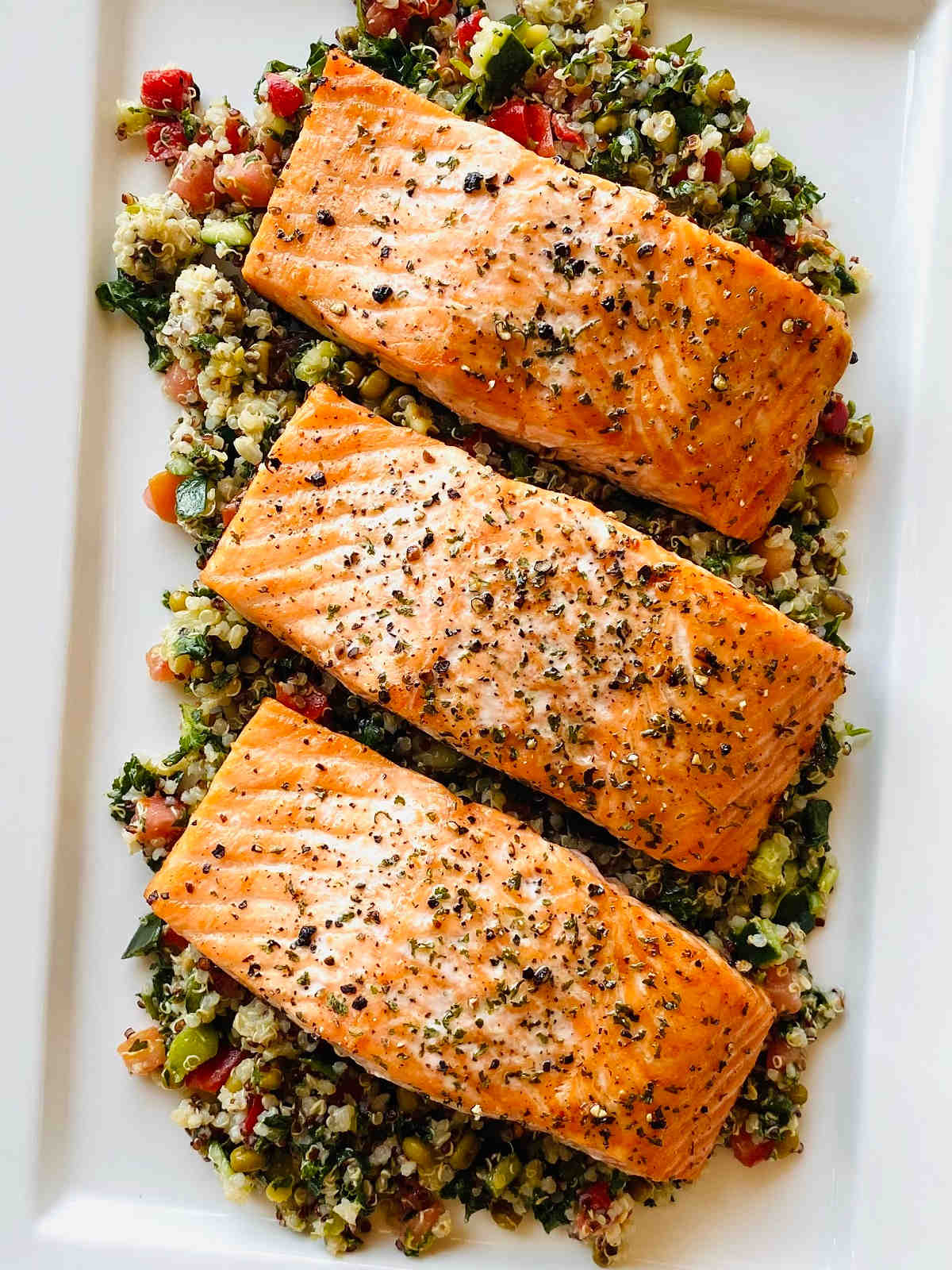
Bold, I know! It is difficult to say what the “best” baked salmon recipe is, as taste preferences can vary greatly from person to person and how to bake salmon really depends!
However, here are some of my favorite recipes for baked salmon (and other salmon cooking varieties!) that should provide some inspiration! I might be just a little bit biased!
- Smoked Salmon
- Grilled Sockeye Salmon Recipe
- Faroe Island Salmon
- Spicy Salmon Bowl
- Pan-Seared Salmon with Spicy Mango Salsa
- Salmon Sashimi
These recipes offer a range of flavors and cooking techniques, and they are all delicious and easy to prepare. Whether you are a seasoned cook or just starting out, if you don’t know how to bake salmon, these recipes will help!
What is the internal temperature recommended by the FDA for cooking fish?
The U.S. Food and Drug Administration (FDA) recommends cooking fish to an internal temperature of 145°F (63°C). This temperature is high enough to kill any harmful bacteria that may be present in the fish, while still keeping the fish moist and tender.
To check the internal temperature of the fish, use a food thermometer to measure the temperature of the thickest part of the fish. If the internal temperature is at least 145°F (63°C), the fish is cooked to a safe temperature and is ready to eat.
Keep in mind that the cooking time for fish and how to bake salmon will depend on the thickness and size of the fillets, as well as the cooking method.
For example, thicker fillets may take longer to cook than thinner ones, and grilling or broiling may cook the fish more quickly than baking or poaching.
Always use a food thermometer to ensure that the fish is cooked to a safe temperature.
FAQ and expert tips
To test for doneness, insert a food thermometer into the thickest part of the salmon. The internal temperature of the salmon should be at least 145°F (63°C), according to the U.S. Food and Drug Administration (FDA).
Yes, you can use any herbs that you like. Some other options might include cilantro, tarragon, or chives. Feel free to mix and match to suit your own taste preferences.
Yes, you can use any type of oil that you prefer. Some other options might include canola oil, vegetable oil, or avocado oil. Keep in mind that the flavor of the oil will be imparted to the salmon, so choose one that you think will complement the fish.
Yes, you can wrap the salmon in foil before baking it. This can help to seal in moisture and prevent the fish from drying out. Just be sure to wrap the foil tightly around the salmon so that it doesn’t leak.
Yes, it is possible to bake salmon from frozen, although it will take longer to cook. To bake frozen salmon, preheat your oven to 425°F (220°C) and place the frozen fillets in a baking dish. Bake for 20-25 minutes, or until the salmon is cooked through. Keep in mind that the cooking time may vary depending on the size and thickness of the fillets.
There are many different ways to cook salmon, including baking it in the oven, cooking it in an air fryer, or using an Instant Pot. The cooking time and method will depend on the type of salmon you are using and your personal preference.
It’s up to personal preference. If you leave the skin on, it will help to keep the salmon moist and flavorful, but it may be more difficult to remove after cooking. If you prefer to remove the skin, you can use a sharp knife to carefully slide it off the fillet.
Yes, you can use either foil or parchment paper to bake the salmon. Using a rimmed baking sheet lined with foil or parchment paper will make it easier to clean up and prevent the salmon from sticking. If you prefer, you can also bake the salmon directly on the baking sheet, just be sure to coat it with olive oil or cooking spray to help it cook evenly and prevent sticking.
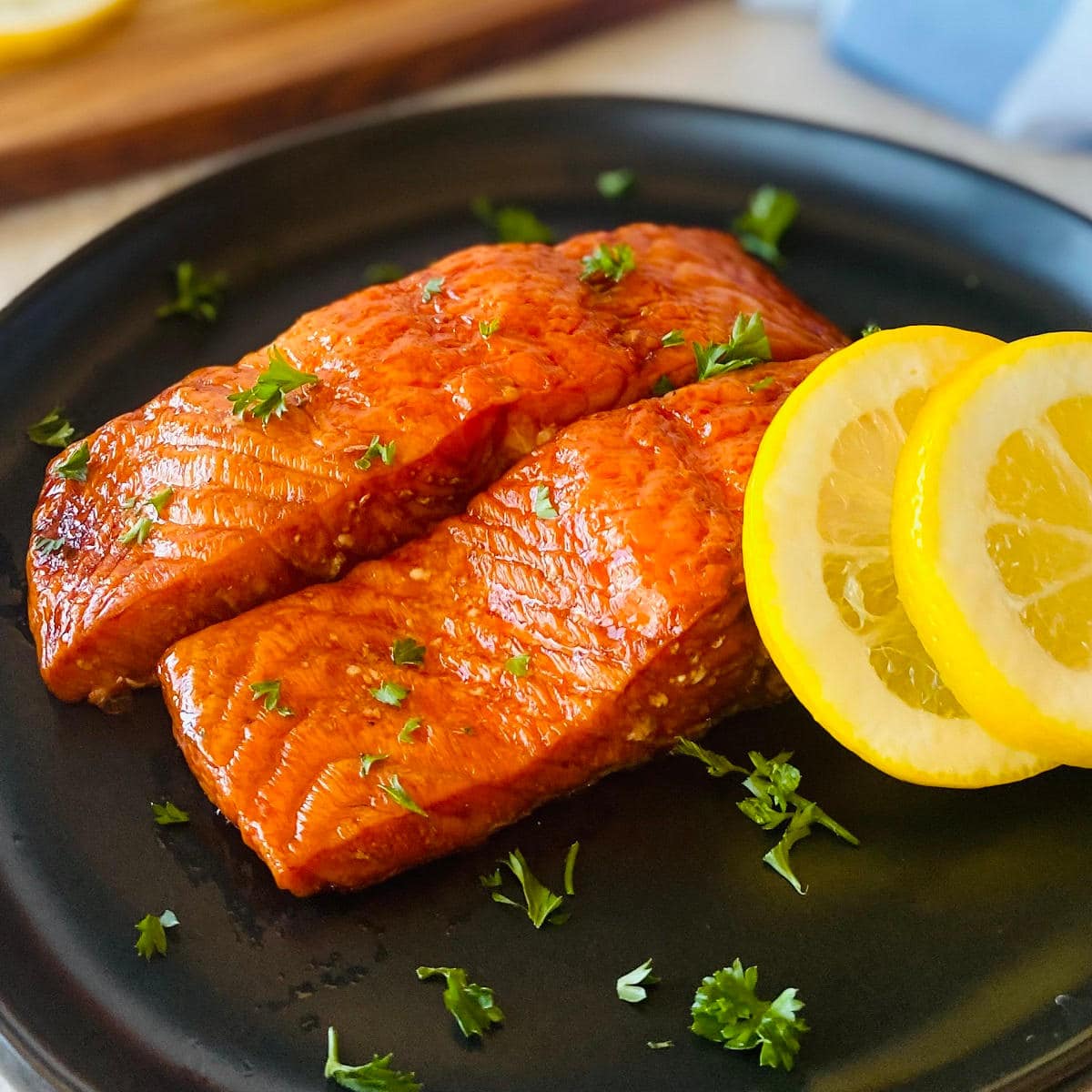
Other easy salmon recipes
Hungry for more? Subscribe to my EMAIL NEWSLETTER and follow me on Facebook, Instagram and Pinterest for all of the latest delicious food!
You can also comment below. I LOVE hearing from you! If you loved the recipe, a 5 STAR RATING is the ultimate compliment as food is my love language!

How to Bake Salmon
Equipment
- 1 Oven
Ingredients
- 4 salmon fillets (6-8 oz each)
- 4 tablespoon olive oil
- 1 tablespoon seasoning of choice (fresh or dried herbs, such as dill, parsley or basil)
- ½ teaspoon salt
- ¼ teaspoon freshly ground pepper
- 1 medium lemon (juiced)
Instructions
- Preheat your oven to 425°F (220°C).
- Pat salmon fillets dry with a paper towel. Place the fillets in a baking dish.
- Brush the salmon fillets with olive oil, using a brush to evenly coat the fish. Sprinkle with seasonings, salt, pepper and/or fresh herbs of choice over the top of the salmon.
- Bake the salmon in the preheated oven for 13-16 minutes, or until it is cooked to your desired level of doneness.
- To test for doneness, insert a food thermometer into the thickest part of the salmon. The internal temperature of the salmon should be at least 145°F (63°C), according to the U.S. Food and Drug Administration (FDA). Continue baking it in 3-minute increments until it reaches the proper temperature.
- Once the salmon is cooked, remove it from the oven and let it sit for a few minutes before serving. This will allow the juices to redistribute and make the salmon even more flavorful and tender.
- Squeeze the juice of fresh lemon on top if desired.


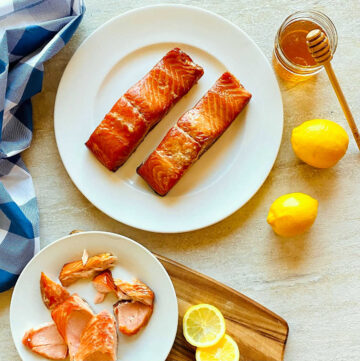
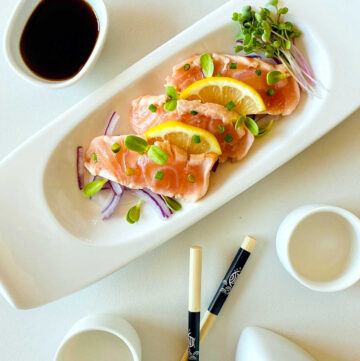
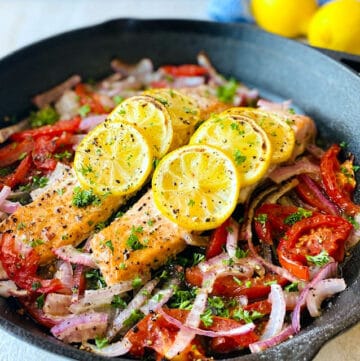
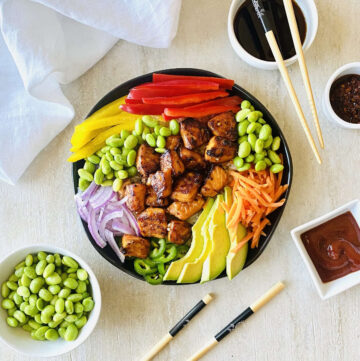
Leave a Reply